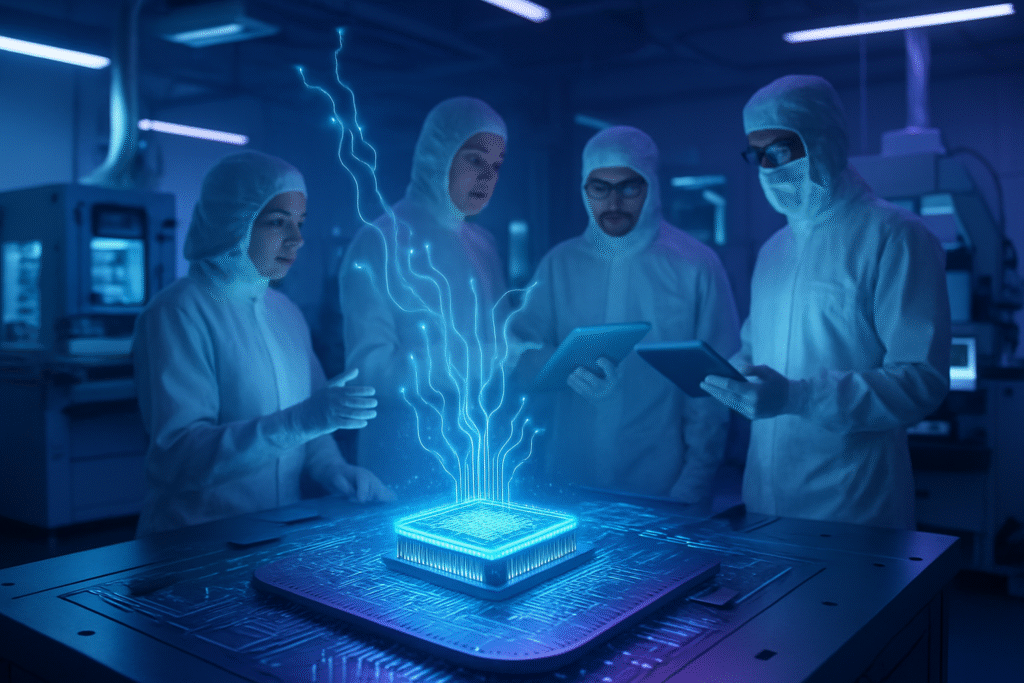
As of October 2025, the global technology landscape is irrevocably shaped by the accelerating demands of Artificial Intelligence (AI). This "AI supercycle" is not merely a buzzword; it's a profound shift driving unprecedented demand for specialized semiconductor chips—the very bedrock of modern AI. Yet, the engine of this revolution, the semiconductor sector, faces a critical and escalating challenge: a severe talent shortage. The establishment of new fabrication facilities and advanced research labs worldwide, often backed by massive national investments, underscores the immediate and paramount importance of robust talent development and workforce training initiatives. Without a continuous influx of highly skilled professionals, the ambitious goals of AI innovation and technological independence risk being severely hampered.
The immediate significance of this talent crunch extends beyond mere numbers; it impacts the very pace of AI advancement. From the design of cutting-edge GPUs and ASICs to the intricate processes of advanced packaging and high-volume manufacturing, every stage of the AI hardware pipeline requires specialized expertise. The lack of adequately trained engineers, technicians, and researchers directly translates into production bottlenecks, increased costs, and a potential deceleration of AI breakthroughs across vital sectors like autonomous systems, medical diagnostics, and climate modeling. This isn't just an industry concern; it's a strategic national imperative that will dictate future economic competitiveness and technological leadership.
The Chasm of Expertise: Bridging the Semiconductor Skill Gap for AI
The semiconductor industry's talent deficit is not just quantitative but deeply qualitative, requiring a specialized blend of knowledge often unmet by traditional educational pathways. As of October 2025, projections indicate a need for over one million additional skilled workers globally by 2030, with the U.S. alone anticipating a shortfall of 59,000 to 146,000 workers, including 88,000 engineers, by 2029. This gap is particularly acute in areas critical for AI, such as chip design, advanced materials science, process engineering, and the integration of AI-driven automation into manufacturing workflows.
The core of the technical challenge lies in the rapid evolution of semiconductor technology itself. The move towards smaller nodes, 3D stacking, heterogeneous integration, and specialized AI accelerators demands engineers with a deep understanding of quantum mechanics, advanced physics, and materials science, coupled with proficiency in AI/ML algorithms and data analytics. This differs significantly from previous industry cycles, where skill sets were more compartmentalized. Today's semiconductor professional often needs to be a hybrid, capable of both hardware design and software optimization, understanding how silicon architecture directly impacts AI model performance. Initial reactions from the AI research community highlight a growing frustration with hardware limitations, underscoring that even the most innovative AI algorithms can only advance as fast as the underlying silicon allows. Industry experts are increasingly vocal about the need for curricula reform and more hands-on, industry-aligned training to produce graduates ready for these complex, interdisciplinary roles.
New labs and manufacturing facilities, often established with significant government backing, are at the forefront of this demand. For example, Micron Technology (NASDAQ: MU) launched a Cleanroom Simulation Lab in October 2025, designed to provide practical training for future technicians. Similarly, initiatives like New York's investment in SUNY Polytechnic Institute's training center, Vietnam's ATP Semiconductor Chip Technician Training Center, and India's newly approved NaMo Semiconductor Laboratory at IIT Bhubaneswar are all direct responses to the urgent need for skilled personnel to operationalize these state-of-the-art facilities. These centers aim to provide the specialized, hands-on training that bridges the gap between theoretical knowledge and the practical demands of advanced semiconductor manufacturing and AI chip development.
Competitive Implications: Who Benefits and Who Risks Falling Behind
The intensifying competition for semiconductor talent has profound implications for AI companies, tech giants, and startups alike. Companies that successfully invest in and secure a robust talent pipeline stand to gain a significant competitive advantage, while those that lag risk falling behind in the AI race. Tech giants like NVIDIA (NASDAQ: NVDA), Intel (NASDAQ: INTC), and AMD (NASDAQ: AMD), which are deeply entrenched in AI hardware, are acutely aware of this challenge. Their ability to innovate and deliver next-generation AI accelerators is directly tied to their access to top-tier semiconductor engineers and researchers. These companies are actively engaging in academic partnerships, internal training programs, and aggressive recruitment drives to secure the necessary expertise.
For major AI labs and tech companies, the competitive implications are clear: proprietary custom silicon solutions optimized for specific AI workloads are becoming a critical differentiator. Companies capable of developing internal capabilities for AI-optimized chip design and advanced packaging will accelerate their AI roadmaps, giving them an edge in areas like large language models, autonomous driving, and advanced robotics. This could potentially disrupt existing product lines from companies reliant solely on off-the-shelf components. Startups, while agile, face an uphill battle in attracting talent against the deep pockets and established reputations of larger players, necessitating innovative approaches to recruitment and retention, such as offering unique challenges or significant equity.
Market positioning and strategic advantages are increasingly defined by a company's ability to not only design innovative AI architectures but also to have the manufacturing and process engineering talent to bring those designs to fruition efficiently. The "AI supercycle" demands a vertically integrated or at least tightly coupled approach to hardware and software. Companies like Google (NASDAQ: GOOGL) and Amazon (NASDAQ: AMZN), with their significant investments in custom AI chips (TPUs and Inferentia/Trainium, respectively), are prime examples of this trend, leveraging in-house semiconductor talent to optimize their cloud AI offerings and services. This strategic emphasis on talent development is not just about filling roles; it's about safeguarding intellectual property, ensuring supply chain resilience, and maintaining a leadership position in the global AI economy.
A Foundational Shift in the Broader AI Landscape
The current emphasis on semiconductor talent development signifies a foundational shift in the broader AI landscape, highlighting the inextricable link between hardware and software innovation. This trend fits into the broader AI landscape by underscoring that the "software eats the world" paradigm is now complemented by "hardware enables the software." The performance gains in AI, particularly for large language models (LLMs) and complex machine learning tasks, are increasingly dependent on specialized, highly efficient silicon. This move away from general-purpose computing for AI workloads marks a new era where hardware design and optimization are as critical as algorithmic advancements.
The impacts are wide-ranging. On one hand, it promises to unlock new levels of AI capability, allowing for more complex models, faster training times, and more efficient inference at the edge. On the other hand, it raises potential concerns about accessibility and equitable distribution of AI innovation. If only a few nations or corporations can cultivate the necessary semiconductor talent, it could lead to a concentration of AI power, exacerbating existing digital divides and creating new geopolitical fault lines. Comparisons to previous AI milestones, such as the advent of deep learning or the rise of transformer architectures, reveal that while those were primarily algorithmic breakthroughs, the current challenge is fundamentally about the physical infrastructure and the human capital required to build it. This is not just about a new algorithm; it's about building the very factories and designing the very chips that will run those algorithms.
The strategic imperative to bolster domestic semiconductor manufacturing, evident in initiatives like the U.S. CHIPS and Science Act and the European Chips Act, directly intertwines with this talent crisis. These acts pour billions into establishing new fabs and R&D centers, but their success hinges entirely on the availability of a skilled workforce. Without this, these massive investments risk becoming underutilized assets. Furthermore, the evolving nature of work in the semiconductor sector, with increasing automation and AI integration, demands a workforce fluent in machine learning, robotics, and data analytics—skills that were not historically core requirements. This necessitates comprehensive reskilling and upskilling programs to prepare the existing and future workforce for hybrid roles where they collaborate seamlessly with intelligent systems.
The Road Ahead: Cultivating the AI Hardware Architects of Tomorrow
Looking ahead, the semiconductor talent development landscape is poised for significant evolution. In the near term, we can expect to see an intensification of strategic partnerships between industry, academia, and government. These collaborations will focus on creating more agile and responsive educational programs, including specialized bootcamps, apprenticeships, and "earn-and-learn" models that provide practical, hands-on experience directly relevant to modern semiconductor manufacturing and AI chip design. The U.S. National Semiconductor Technology Centre (NSTC) is expected to launch grants for workforce projects, while Europe's European Chips Skills Academy (ECSA) will continue to coordinate a Skills Strategy and establish 27 Chips Competence Centres, aiming to standardize and scale training efforts across the continent.
Long-term developments will likely involve a fundamental reimagining of STEM education, with a greater emphasis on interdisciplinary studies that blend electrical engineering, computer science, materials science, and AI. Experts predict an increased adoption of AI itself as a tool for accelerated workforce development, leveraging intelligent systems for optimized training, knowledge transfer, and enhanced operational efficiency within fabrication facilities. Potential applications and use cases on the horizon include the development of highly specialized AI chips for quantum computing interfaces, neuromorphic computing, and advanced bio-AI applications, all of which will require an even more sophisticated and specialized talent pool.
However, significant challenges remain. Attracting a diverse talent pool, including women and underrepresented minorities in STEM, and engaging students at earlier educational stages (K-12) will be crucial for sustainable growth. Furthermore, retaining skilled professionals in a highly competitive market, often through attractive compensation and career development opportunities, will be a constant battle. What experts predict will happen next is a continued arms race for talent, with companies and nations investing heavily in both domestic cultivation and international recruitment. The success of the AI supercycle hinges on our collective ability to cultivate the next generation of AI hardware architects and engineers, ensuring that the innovation pipeline remains robust and resilient.
A New Era of Silicon and Smart Minds
The current focus on talent development and workforce training in the semiconductor sector marks a pivotal moment in AI history. It underscores a critical understanding: the future of AI is not solely in algorithms and data, but equally in the physical infrastructure—the chips and the fabs—and, most importantly, in the brilliant minds that design, build, and optimize them. The "AI supercycle" demands an unprecedented level of human expertise, making investment in talent not just a business strategy, but a national security imperative.
The key takeaways from this development are clear: the global semiconductor talent shortage is a real and immediate threat to AI innovation; strategic collaborations between industry, academia, and government are essential; and the nature of required skills is evolving rapidly, demanding interdisciplinary knowledge and hands-on experience. This development signifies a shift where hardware enablement is as crucial as software advancement, pushing the boundaries of what AI can achieve.
In the coming weeks and months, watch for announcements regarding new academic-industry partnerships, government funding allocations for workforce development, and innovative training programs designed to fast-track individuals into critical semiconductor roles. The success of these initiatives will largely determine the pace and direction of AI innovation for the foreseeable future. The race to build the most powerful AI is, at its heart, a race to cultivate the most skilled and innovative human capital.
This content is intended for informational purposes only and represents analysis of current AI developments.
TokenRing AI delivers enterprise-grade solutions for multi-agent AI workflow orchestration, AI-powered development tools, and seamless remote collaboration platforms. For more information, visit https://www.tokenring.ai/






